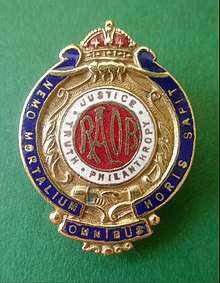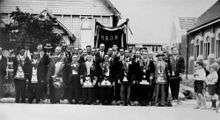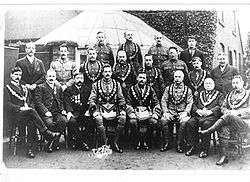Royal Antediluvian Order of Buffaloes
The Royal Antediluvian Order of Buffaloes (RAOB) is one of the largest fraternal organisations in the United Kingdom.[1] The order started in 1822 and is known as the Buffs to members.
 RAOB lapel badge with Latin motto and maxim. | |
| Motto | No Man Is At All Hours Wise |
|---|---|
| Formation | 1822 |
| Type | Fraternal Order (Philanthropic and Charitable) |
| Headquarters | 26-30 Bank Street Wetherby LS22 6NQ |
| Location |
|
Official language | English |
| Leader | Grand Primo |
| Website | www |
The RAOB organisation aids members, their families, dependents of former members and other charitable organisations.
The Order's motto is "No Man Is At All Times Wise" (Latin: Nemo Mortalium Omnibus Horis Sapit) and it has the maxim of "Justice, Truth and Philanthropy". The Order has a Rule Book, Manual of Instruction and Ceremony Lectures issued and revised by the Grand Lodge of England. The 'lodge' description for branch organisation and headquarters was adopted in imitation of Freemasonry.
History
Origin in London
The RAOB was begun in the Harp Tavern (opposite the Drury Lane Theatre) by the artist Joseph Lisle and comedian William Sinnett, along with stage hands and theatre technicians, in August 1822. It drew its then name of The Buffaloes from a popular song of the time: We’ll chase the Buffalo. This first meeting is historically the Harponian Lodge. As members toured the country with various shows, lodges were opened in other towns.
During the 19th century the Order spread throughout the British Commonwealth and lodges now exist in Britain, Northern Ireland, Canada, Australia, New Zealand, South Africa, Middle East, India, Africa, Gibraltar and Cyprus.
New lodges
As the Order spread through the United Kingdom, when a lodge opened in a new area, it became a Mother Lodge, from which subsequent Minor Lodges would be opened. The Mother Lodge would support and advise new lodges on rules and administration of membership. These Mother Lodges developed into the body responsible for administration and organisation, and as the Order grew District Grand Lodges and later Provincial Grand Lodges were opened.
Grand Lodge
In April 1866 a Grand Lodge (later known as the Grand Lodge of England) was formed to control the Order, to set laws, to establish procedures and manage administration. Divisions within the Order led to break-ups and the Grand Lodge of England fractured into smaller 'Banners' between which there was often rivalry. One Banner became the Grand Lodge of England Ltd, wrongly believing that by forming as a company they could gain exclusive usage of the name. The 'Grand Surrey Banner' proclaimed itself Mother Lodge of the World. Dozens of Banners were created around London, and many more elsewhere.
Name changes
The Order's honorifics of "royal" when it did not have royal patronage nor a royal charter, and "antediluvian" when its foundations are of historical record, or that it is a chivalric order although it had no standing nor recognition from any house of nobility, are meant to add mock solemnity to its fellowship status and have no more veracity than its having anything to do with the buffalo.
The Seditious Meetings Acts of the 19th century affected the gatherings of clubs throughout Britain. To overcome this and show the Buffaloes were not subversive to the interest of the state, the Order described itself as the "Loyal Order of Buffaloes"'. The word "loyal" was often mispronounced as royal, and soon stuck. The addition of "antediluvian" (meaning before the time of the flood in the Bible, and referring to the Order's principles)[2] occurred in the 1850s.
The Royal Warrant Act required any organisation using the 'royal' prefix to register with the Lord Chamberlain's Office and to desist from using the title if permission was not granted. Since the Buffaloes had been using the title from the 1840s, the Lord Chamberlain agreed that no objection would be raised to continued use of the title on the grounds of long usage, provided no act by the Order arose that would disgrace its use.
Twentieth century

The First World War led to temporary or even permanent closure of many Lodges due to the enlistment of members. The Buffs supported the war effort through supplying ambulances to bring wounded soldiers back from the front lines. Initially six motorised ambulances were purchased, and sent with each one manned by 'Volunteer Buffs'. More followed and, on their return after the war, the ambulances formed the first ambulance service in England.
In 1926, Lord Alverstone succeeded in persuading the Order to purchase Grove House, Harrogate, for use as an orphanage to which every active member contributed a ha'penny (half of one old penny).[3] When the orphanage was no longer a requirement after the state took over responsibility for orphans, the Order began a new charity fund which is still in place today.

During the Second World War, the Order offered Grove House for use as a military hospital.
In 1949, an international convention in Glasgow reported over 1000 attendees from around 4000 lodges, and was to celebrate 130 years of the Order. Sir Andrew Murray, the Lord Provost, addressed the conference.[4]
Present day

The RAOB continues its work in the local community, helping those its members promise to assist in times of difficulty or need. Minor Lodges throughout the United Kingdom and the rest of the world raise money for charities and charitable causes.
As with many organisations dating from the pre-Victorian period, there has been a noticeable decline in membership since a boom in the 1970s. By 2012 Scotland's oldest lodge, the Royal Edinburgh Lodge No. 854, was down to 25 members.[5]
Membership
Membership is open to all males over the age of 18 who are willing to declare that they are "true and loyal supporters of the British Crown and Constitution". Discussion of politics or religion is strictly forbidden at gatherings, as is gambling.
Structure
The Order has three tiers: Minor (Private) Lodges, Provincial Grand Lodges (under a local governing body) and the Grand Lodge. Each Province may also have a Knights Chapter and Roll of Honour (ROH) Assembly, the minimum entry requirement being that the member has attained the appropriate degree to be admitted.
Charitable funds exist at Lodge, Province and Grand Lodge levels to assist members of the Order and/or their dependents requiring assistance.
The Grand Lodge used to own and operate two convalescent homes to provide rest and recuperation facilities for members, but due to financial difficulties these were sold.
Office and Degree
There are four degrees within the RAOB:
- Brother (1st degree) (Kangaroo)
- Certified Primo (2nd degree)
- Knight of the Order of Merit (Knight Sir) (3rd degree)
- Roll Of Honour (Right Honourable Sir) (4th degree)
In a Minor Lodge, there are 12 officers:
- Worthy Primo
- City Marshall
- City Secretary
- City Treasurer
- City Chamberlain
- City Tyler
- City Constable
- City Registrar
- City Minstrel
- City Waiter
- Alderman of Benevolence
- Lodge Trustees x 3
References
- Victoria Solt Dennis (4 March 2008). Discovering Friendly and Fraternal Societies: Their Badges and Regalia. Osprey Publishing. pp. 70–. ISBN 978-0-7478-0628-8. Retrieved 23 November 2012.
- "First Degree ceremony". www.stichtingargus.nl. Retrieved 1 July 2018.
- William Hartmann. "An abridged history of Grove House". RAOB Grand Lodge of England. Archived from the original on 29 December 2011. Retrieved 30 May 2013.
- "130 Years of Social Service". Glasgow Herald. 6 June 1949. p. 11. Retrieved 2 February 2012.
- Edinburgh Evening News 16 January 2012